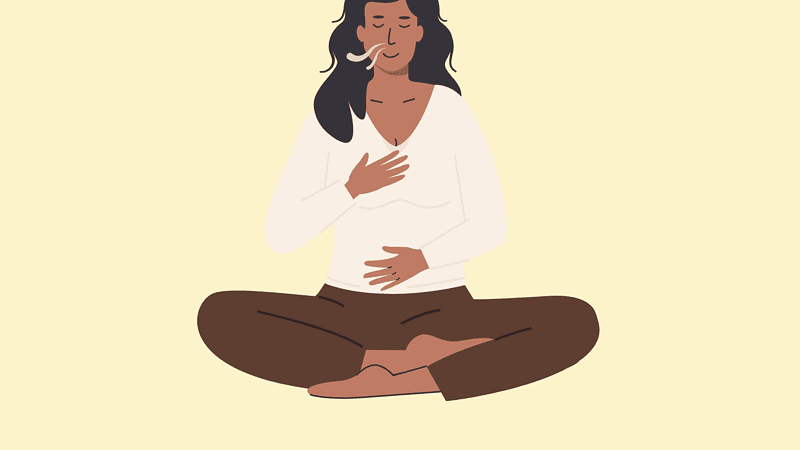
Breathing Space Among the Plants
Harnessing Plants for Air Quality and Wellness - Maria Georgieva
Reading time: 4 minutes
The benefits of long, slow, deep breathing cannot be overestimated. Lung collapse and pneumonia caused by shallow breathing is a common complication post-surgery under full anaesthesia and can be life-threatening.
Yoga taught abdominal breathing helps flush the lungs, raising the level of oxygen in the blood and subsequently in all body cells, refreshing the brain and easing the job of the heart. But the role of pranayama (or breath control) for harnessing the autonomic nervous system can prove even more crucial in a world where anxiety is the most common mental health disorder. Nothing regulates the response of the panicking vagus nerve faster than a calming breathing pattern.
Deep mindful breathing might just be the secret for longevity hidden in plain sight, if only reliable access to fresh air was not equally part of the picture.
Without food the maximum time the body can survive is thought to be three months. Without water - it is one week. Without air - not more than three minutes. So it comes as no surprise that air pollution and climate change were jointly named the topmost global health hazard by the WHO. There are plenty of reasons why the quality of our air is getting worse.
A vast proportion of the world population nowadays lives in cities - or more precisely - fast growing urban sprawls full of traffic, fumes, dust, noise, and airborne human microbes.
On top of that most of us spend upwards of 80% of our time indoors - in poorly ventilated spaces, often ridden with mould spores, mites, tiny particles known as PM (particulate matter) and chemicals leached by paint, furniture and cleaning agents - summed under the bracket of VOCs - volatile organic compounds.
Entire industries have emerged, busy to monitor, condition and filter the air via intricate gadgets and systems, and many designers have turned our gaze to natural materials and low VOC products to minimise the harm. But could it be that the answer is a lot less technical and a lot greener - tackling both air pollution and carbon emissions at the same time?
There is a NASA study from 1989 about the powers of house plants to clean up the indoor air from pollutants. The examined plants were a dozen varieties available in the local nursery. That single study led thousands of wellbeing authors over the years to churn advice on which plants and how many would purify our bedroom air best.
Peace lilies, snake plants and aloes all got a lot of propagation (and propaganda) because of it. It is now labelled ‘commonly misquoted’, as later research found the effects difficult to replicate in regular housing conditions since we would need roughly 230 medium sized plants per 50 square metres.
Ok, maybe a couple of succulents won't do it and opening the window more often will deliver a faster purge, but it is still true that plant nurseries do need to top up the in-house carbon dioxide levels as the plants consume vast amounts for their photosynthesis while growing actively in sunny weather. Called ‘carbon dioxide enrichment’, the top-up is often done by burning fossil fuels inside the greenhouse.
Now, wait a minute! Is it me or is that ironic and unnecessary?
Let's go back to the numbers. Plants consume CO2 only throughout the day and for every 100m2 of nursery area it is about 0.2kg per hour. Each of us typically exhales 0.029kg of CO2 per hour and up to eight times more if exercising vigorously. This means that a 12.5 long by 8 metres wide nursery can offset the carbon for up to 7 people.
However greenhouses typically get an extra 1.15kg CO2 supply per hour per 100m2 to offset air leakages - quantity equal to the carbon dioxide exhaled by no less than 40 people!
Well, how about solving two issues at once by exercising among the plants? While populating our bedrooms with hundreds of peace lilies may be dangerous during the night when they start consuming oxygen and exhaling CO2 just like us, stocking a daytime-use fitness-dedicated room with plants (in high racks to free floor space) might just remove the need for air conditioning and give the crops that extra carbon to grow better.
House plants thrive and exercise spaces work best at 18 to 20 C°, so there are no issues with the heating range. 50% humidity is great for both humans and leafy friends. Plentiful natural light boosts the mood and improves sleep. Newer research shows that astronauts feel better when sharing a room with a strawberry and a cilantro plant1 - helpfully edible as well as uplifting.
The best bit is that garden fitness centres like this can be built in the middle of the city, on rooftops, over concrete and derelict courtyards - serving as oxygen bubbles and urban lungs where fresh air is needed the most.
They will be fast and inexpensive to put together, and would offset the building and maintenance costs quickly by retailing the green produce along with the exercise classes and any other merchandise - so even deprived communities will be able to afford one.
Call me a dreamer, but I would love to see this trend pick up, just like the ‘nature house’ (naturhus2) movement in the Scandinavian countries.







